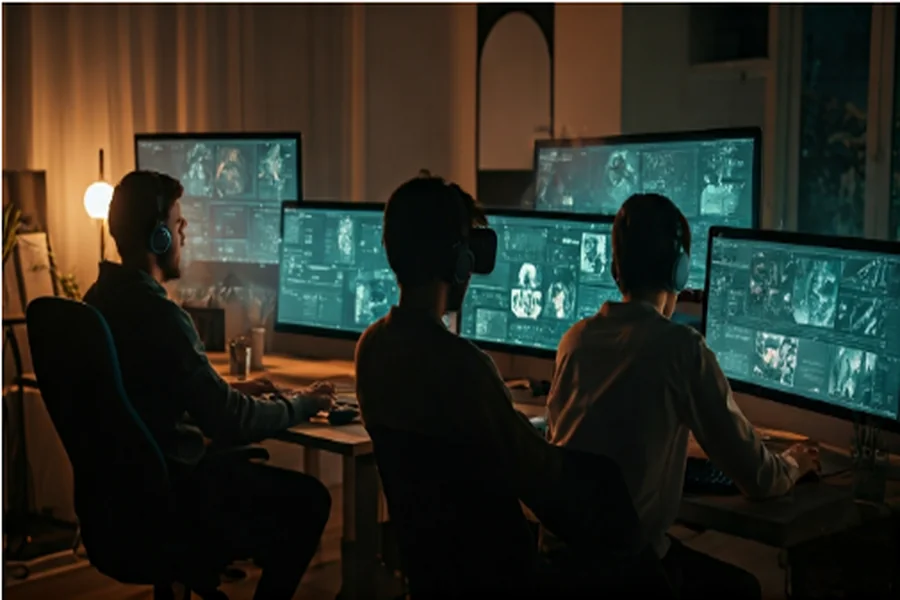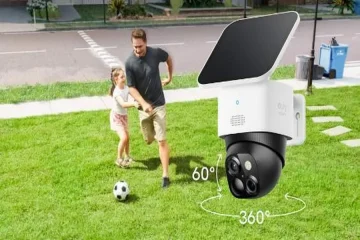Key Highlights
- VR game development companies now operate efficiently with remote teams, leveraging virtual reality collaboration tools and agile software development pipelines.
- Leading studios integrate freelance and remote VR game developers into their workflows, enabling access to global talent for immersive experiences.
- Essential collaboration relies on advanced development tools, including version control, game engines like Unreal Engine, and VR-ready hardware such as HTC Vive and Oculus Rift.
- These companies deliver virtual reality solutions for a range of industries, from gaming to healthcare.
- Success stories highlight seamless cross-platform compatibility and interactive, user-focused design.
Introduction
Virtual reality game development has entered a new era, where remote collaboration is not only possible but highly effective. With immersive technology rapidly advancing, studios can now build high-quality VR games and interactive experiences without needing everyone in the same office. The shift to remote work, fueled by reliable development tools and cloud-based workflows, means that virtual reality developers can innovate and deliver cutting-edge virtual reality solutions from anywhere in the world. This flexibility has changed the way immersive experiences are created.
The Rise of Remote VR Game Development Companies
Remote game development has surged in recent years, thanks to robust virtual reality technology and the growing demand for VR games. Game studios are harnessing remote teams to meet the needs of a booming vr market, which is projected to grow from $32.64 billion in 2024 to $244.84 billion by 2032.
For a professional VR game development company, the process often starts with gathering client requirements and forming a distributed team. Remote operations allow studios to tap into specialized skills globally, enhancing both creativity and efficiency in virtual reality projects.
Evolution of Virtual Reality and Remote Collaboration
Immersive technology has evolved rapidly, making it easier for studios to collaborate remotely on complex VR solutions. In the early days, virtual reality technology development was restricted to in-house teams due to the need for specialized equipment. Today, cloud-based platforms and advanced communication tools enable seamless remote collaboration, letting game developers work together in shared virtual environments from anywhere in the world.
This transformation has broadened the scope of VR projects across various industries. Healthcare, education, architecture, and entertainment are just a few genres benefiting from innovations made by virtual reality game development companies. Studios now use immersive technology not only for gaming but also for training simulations, virtual tours, and professional education experiences.
The ability to build, review, and refine vr games collaboratively in real time has revolutionized how teams operate. As remote work becomes the norm, the future of VR solutions looks more interconnected and global than ever before.
Benefits of Remote Game Development for Studios and Clients
Today’s game development landscape offers more flexibility and opportunity than ever before, especially through remote collaboration. Studios and their clients benefit from a broader talent pool, reduced costs, and faster project delivery.
Remote VR development services offer several key advantages:
- Access to specialized game developers worldwide, adding unique skills to every project.
- Streamlined communication and project updates thanks to digital tools.
- Cost savings due to fewer overheads for office space and infrastructure.
- Greater adaptability in accommodating client feedback and revisions.
When choosing a virtual reality game development company for your project, look for proven expertise, an impressive portfolio, technical proficiency in vr technologies, and strong client communication. Ask about their experience with immersive experiences, ability to deliver cross-platform solutions, and post-launch support to make sure they are a reliable partner for your needs.
Building a Remote-First VR Game Development Team
For a modern vr development company, building a remote-first team starts with assembling skilled vr game developers and robust digital infrastructure. The key is finding a reliable partner who can manage remote work effectively and maintain high standards of communication and performance.
Companies invest in advanced virtual environments, secure collaboration systems, and agile pipelines. By doing so, they enable team members—from full-time developers to freelancers—to work together seamlessly, share assets, and contribute to innovative game development projects. This approach ensures flexibility and global reach.
Hiring Remote and Freelance VR Developers
Hiring freelance or remote vr game developers has become common, letting studios adapt quickly to project demands. Companies look for candidates with expertise in 3D modeling, virtual environments, and immersive storytelling. Strong communication skills and familiarity with collaborative development tools are also essential.
Studios use specialized platforms to find top freelance VR talent, ensuring each developer’s experience matches project needs. Onboarding includes clear documentation, defined roles, and access to the studio’s remote workflow systems.
Some of today’s top-rated virtual reality game development companies include:
- Euphoria XR: Custom vr games, AR/VR development, 360-degree video production, and virtual reality training.
- Groove Jones: Interactive VR campaigns and training simulators for brands like Toyota.
- Cubix: VR game development and enterprise apps, focusing on gamified training.
- Lucid Reality Labs: Immersive experiences for healthcare and education industries. These companies deliver a range of key services, from concept design to post-launch support, by integrating remote developers into their pipelines.
Onboarding and Integrating Remote Talent into Company Culture
Successfully integrating remote talent into company culture is vital for delivering top-tier vr development and user experience. Studios invest in structured onboarding, ensuring new hires are familiar with interactive experiences and the company’s mission.
Key steps for smooth integration:
- Provide clear guidelines on workflows, project values, and communication standards.
- Assign mentors or buddies to help new hires navigate virtual environments.
- Use regular video meetings and VR collaboration spaces to build team connections.
- Celebrate achievements and encourage feedback to strengthen engagement.
Questions to ask a VR game development company before starting a project include: What is your process for onboarding remote team members? How do you ensure a consistent company culture in a distributed team? What tools do you use for collaboration and workflow management? By focusing on these areas, studios create an engaging, creative, and collaborative atmosphere for both in-house and remote developers.
Core Technologies Powering Remote VR Game Development
The backbone of any remote vr game development operation is its use of cutting-edge development tools and vr technologies. Game engines, asset management platforms, and real-time collaboration software enable distributed teams to create and review immersive experiences together.
By leveraging remote access to powerful hardware, such as VR-ready workstations and headsets, studios can develop, test, and optimize virtual reality games for different platforms. These advancements make remote workflows not only feasible but also highly productive for teams building innovative VR projects.
Essential Hardware and Software Tools for Collaboration
The right mix of hardware and software is crucial for collaborative vr app and software development. Studios equip their teams with VR headsets like HTC Vive and Oculus Rift, which support real-time testing and iteration in virtual environments. Developers also rely on powerful workstations capable of handling intensive 3D rendering.
On the software side, a range of tools streamlines remote work:
- Project management platforms for tracking tasks and deadlines.
- Source control systems for managing code and assets.
- Cloud-based file sharing for easy collaboration.
- VR-specific development environments for building and debugging immersive experiences.
When choosing a virtual reality game development company, ask about the hardware (such as the VR headsets and testing devices) and software (including game engines and asset management systems) they use. Leading companies often favor Unity or Unreal Engine for their flexibility and robust feature sets.
Popular Game Engines and Development Platforms Used Remotely
Remote VR game development relies heavily on versatile game engines and platforms. Unreal Engine and Unity are the industry standards, supporting high-quality graphics, seamless cross-platform compatibility, and efficient workflows for remote teams. These engines empower developers to create complex interactive experiences, while cloud-based collaboration platforms allow for real-time asset sharing and feedback.
Here’s a breakdown of the most commonly used platforms:
| Game Engine / Platform | Key Features | Remote Collaboration Support | Platforms Supported |
| Unity | Cross-platform, user-friendly, large asset store | Cloud builds, version control plugins | Oculus Rift, HTC Vive, Pico Neo, iOS |
| Unreal Engine | Advanced graphics, real-time rendering, VR templates | Perforce/Git integration, Live Link | PC VR, PlayStation VR, Meta Quest |
| Pico VR SDK | Optimized for Pico hardware, spatial tracking | API support, collaborative features | Pico Neo, Pico 4 |
Leading VR development companies ensure cross-platform compatibility by using these engines’ built-in multi-device support and thorough testing on various hardware. This guarantees their vr games and experiences reach the widest possible audience.
Version Control and Agile Pipelines in Remote Workflows
Effective software development for VR relies on robust version control and agile methodologies, especially with remote teams. Version control tools manage code changes and digital assets, preventing conflicts and data loss. Agile pipelines help distributed teams organize tasks, track progress, and adapt to feedback quickly.
These practices provide structure and transparency, letting developers and clients follow project milestones easily. The result is a streamlined, reliable workflow that delivers high-quality immersive experiences with every release.
Managing Codebases and Digital Assets in Distributed Teams
Managing codebases and digital assets remotely is a core challenge for distributed teams in VR game development. Studios use specialized version control systems to keep all files and source code organized, allowing game developers to work simultaneously without conflicts.
Digital asset management platforms are used to store and share 3D models, textures, and audio files. These platforms support real-time updates, so changes made by one team member appear instantly for others, keeping the virtual reality game development process transparent and efficient.
A typical professional VR game development process includes requirement analysis, prototyping, design and development, integration and testing, deployment, and post-launch support. Each step relies on synchronized tools to minimize errors and improve collaboration, resulting in seamless, immersive gaming experiences.
Adapting Agile Methodologies for Virtual Collaboration
Adapting agile methodologies for virtual collaboration is critical to modern vr game development services. Agile practices, such as daily stand-ups and sprint reviews, keep remote teams aligned and responsive to client feedback.
Key facets of agile virtual collaboration include:
- Clear documentation of user stories, technical requirements, and project milestones.
- Regular virtual meetings to discuss progress and challenges.
- Iterative testing and review cycles for continuous improvement.
- Transparent communication channels to resolve issues quickly.
For cross-platform compatibility, top VR studios use agile sprints to test their games on multiple devices, refining performance for Oculus Rift, HTC Vive, and others. These practices, combined with agile project management, ensure that VR development services deliver reliable, engaging, and immersive gaming experiences on time and budget.
Success Stories: Leading Remote VR Game Development Projects
The effectiveness of remote workflows in VR game development is best seen in notable project successes. Leading vr development companies have delivered complex vr solutions such as training simulations and interactive educational platforms without a centralized office.
These achievements span industries ranging from aviation to healthcare, showing the power of remote teams and innovative tools. The following case studies and lessons from top virtual reality studios illustrate how remote collaboration can produce world-class immersive experiences.
Notable Case Studies of Remote VR Game Launches
Several successful vr game launches highlight the value of remote collaboration. For example, Juego Studios developed a jet bridge simulation for aviation training entirely with remote talent. This immersive virtual reality training solution allowed operators to practice critical skills in a safe environment, reducing errors in real-world operations.
Another standout project is 3D Organon, a remote-built VR platform for healthcare training. It features over 4,000 anatomical structures, interactive dissections, and quizzes, fostering collaborative learning for classrooms and study groups.
Key takeaways from these case studies:
- Remote teams can deliver complex, innovative vr games across various industries.
- Interactive learning and professional training are now possible at scale through virtual reality.
- Seamless integration of freelance and in-house developers accelerates project timelines without sacrificing quality.
Lessons Learned from Top Performing Virtual Reality Studios
The top virtual reality studios have learned valuable lessons from running distributed teams and delivering high-quality vr development projects. First, clear communication and robust technical infrastructure are essential for managing remote workflows. Studios must invest in advanced collaboration tools and thorough onboarding for each new remote developer.
Game design and immersive gaming experiences improve when studios embrace diversity in their teams, drawing on specialized skills from around the world. According to Jonathan Fitzgibbons, Project Manager at United Airlines, “Had a wonderful time working with team who was always well versed with technicalities and precise with timelines, deliverables and project planning.”
The typical process followed by a professional VR game development company involves detailed planning, agile sprints, and post-launch support. By focusing on these best practices, virtual reality studios consistently produce engaging, cross-platform games and solutions.
Conclusion
In conclusion, the landscape of virtual reality game development is rapidly evolving, and remote collaboration is at the forefront of this transformation. By leveraging advanced technologies and effective communication tools, studios can create innovative games while accessing a global talent pool. Whether you’re hiring remote developers or integrating agile methodologies into your workflow, understanding the dynamics of remote collaboration is essential for success. As the industry continues to thrive, embracing these strategies will not only streamline your development process but also enhance creativity and efficiency. If you’re ready to take your VR game project to the next level, consider scheduling a free consultation with our team to explore how we can support your vision.
Frequently Asked Questions
How much does it cost to hire a remote VR game development company?
The project cost for hiring a vr development company varies widely. Simple VR games may start at $30,000, while complex, feature-rich experiences can exceed $250,000. Factors influencing the price include project complexity, features, timeline, and expertise of the vr game development team.
What is the average project timeline for remote VR game development?
A typical vr game development project timeline can range from a few weeks to several months. Basic games may take 2-3 months, while larger projects with advanced features could require 6-12 months. Timelines depend on project scope, technical requirements, and the number of game developers involved.
What should I ask before starting a VR game project with a remote company?
Before beginning your game development with a remote team, ask about their vr game development services, experience with immersive technology, project management methods, and client communication. Ensure they can deliver as a reliable partner and provide ongoing support for your vr solutions and interactive experiences.




